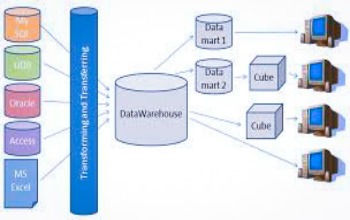For an ordinary person, we likely hear crickets chirping when we hear others talk extensively about computers using unheard of computer jargons. Understanding many of these computer concepts and terms isn’t an easy feat, so we often just stick to what we know best: social media and the Internet.
 However, if you are an entrepreneur, you need to familiarize yourself with these tech concepts especially if you have plans of expanding your business across different platforms and corners of the globe. Going digital is inevitable and you need to have a great and efficient computing system in place to manage and store your data, so you know just what is happening to your business all the time.
However, if you are an entrepreneur, you need to familiarize yourself with these tech concepts especially if you have plans of expanding your business across different platforms and corners of the globe. Going digital is inevitable and you need to have a great and efficient computing system in place to manage and store your data, so you know just what is happening to your business all the time.
To quote the Data Warehouse Institute (TDWI) from WhereScape’s own pages, “Data warehouse automation is much more than simply automating the development process. It encompasses all of the core processes of data warehousing including design, development, testing, deployment, operations, impact analysis, and change management.”
(Via: http://www.computerweekly.com/blog/CW-Developer-Network/What-is-data-warehouse-automation)
Simply put, data warehouse automation is a process wherein you automate and accelerate the development cycles of data warehouse without compromising consistency and quality. In short, you just automate the entire process. This is especially helpful in big enterprises that handle big data in their daily operations to let you do more things quite faster without spending a fortune on it.
So online grocery is hard, and doing it profitably demands extraordinary levels of efficiency powered by the creative application of technology and automation. For a traditional retailer, building that solution is a massive and daunting prospect. Yet online is also a phenomenon that is here to stay, because customers want the convenience, enjoy the choice, and appreciate the time they don’t have to waste trudging around a conventional store.
The great thing about having an online grocery delivery pipeline into customers’ homes is that, once it’s in place and being used regularly, all manner of other products and services can potentially flow up and down it. If you can do online grocery, then you can do some other forms of online retail; but the reverse definitely does not implicitly follow. The potential size of the worldwide online grocery market combined with these spin-off opportunities is why grocery really is the holy grail of online retail.
That’s the end business case we put forward at Ocado, the world’s largest online-only grocery retailer, currently operating in the UK. Unlike other online retailers, our customers’ orders are picked and packed in huge automated warehouses before being delivered to their kitchen tables in one-hour slots by Ocado’s own delivery fleet. All the technology that powers this disruptive business model has been built in-house over the past 17 years. Ocado has been profitable at an order level for many years but has chosen to invest heavily in building its technology platform.
(Via: https://hbr.org/sponsored/2017/05/how-an-online-grocery-platform-could-reshape-retail-as-we-know-it)
Although generally used by a local business, an online grocery system is the perfect smaller-scale example of data warehouse automation at work. They have an extensive yet efficient data management system in place to keep track of inventory, supplier details, customer details and many others. It ensures the grocers move the items on time to gain profits and cut down on losses from spoiled produce.
It’s not clear if Amazon has made any strides towards developing the futuristic "robot vans" mentioned in the CNBC story. But considering this is the company that recently made its first delivery by drone, the prospect doesn’t really seem that farfetched.
The big upside for automated delivery is the savings that come from operating with no labor costs and maximum efficiency. As the Barclays report notes, 80% of grocery delivery costs are attributed to labor expenses and wages. The upfront investment needed to install this technology is significant, but this is where Amazon has a significant advantage. The e-commerce giant has capital to burn. Low-margin traditional retailers, by contrast, just don’t have as much money to invest in this kind of advanced technology.
Combined with Amazon’s data-mining capabilities, growing infrastructure and flat-out ambition to become a dominant player in grocery, automation offers another way for the online retailer to quickly scale up. Granted, that may not seem like much of a threat given the company’s current operations. So far, AmazonFresh has grown very slowly, expanding to just over a dozen markets in the span of 10 years.
(Via: http://www.fooddive.com/news/grocery--can-amazon-earn-grocery-dominance-with-more-automation/441720/)
Another great example of a company that uses data warehouse automation and became successful at it is no other than Amazon itself. Amazon Fresh provided an avenue for online grocery retailers to reach out to a wider market by selling their products online and providing grocery delivery in America. People these days prefer online shopping rather than going to physical stores and supermarkets to shop for things, which is why companies that can master the process of data warehouse automation may hit the jackpot and thrive where others have failed.
Meanwhile, the problem of hard drive failure and the consequent data loss is an issue experienced by almost everyone now and then. When that happens to you and you are using a Seagate hard drive, this link http://www.harddriverecovery.org/seagate-data-recovery.html may help you understand what really happens during its recovery. If you are using an older system, though, like a RAID 10, this post on RAID 10 Data Recovery http://www.harddriverecovery.org/raidcenter/raid-10-data-recovery.html is probably what you are looking for to help you fully understand how to recover lost data using this system.
Understanding Data Warehouse Automation was first published on Hard Drive Recovery Group
source http://www.harddriverecovery.org/blog/understanding-data-warehouse-automation/
No comments:
Post a Comment